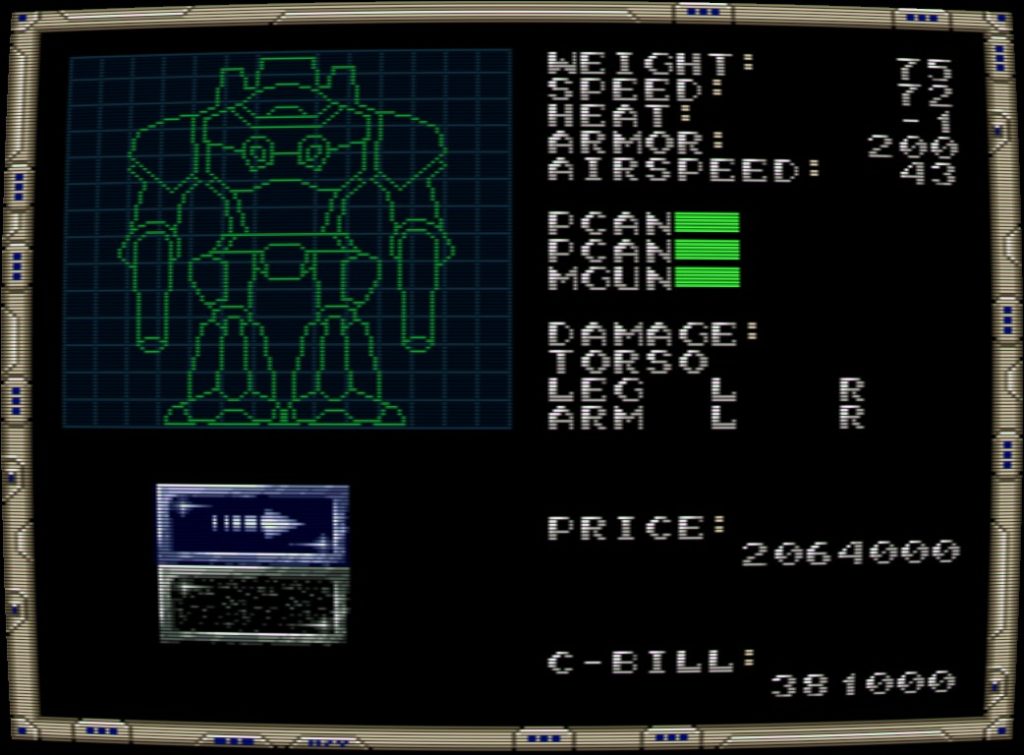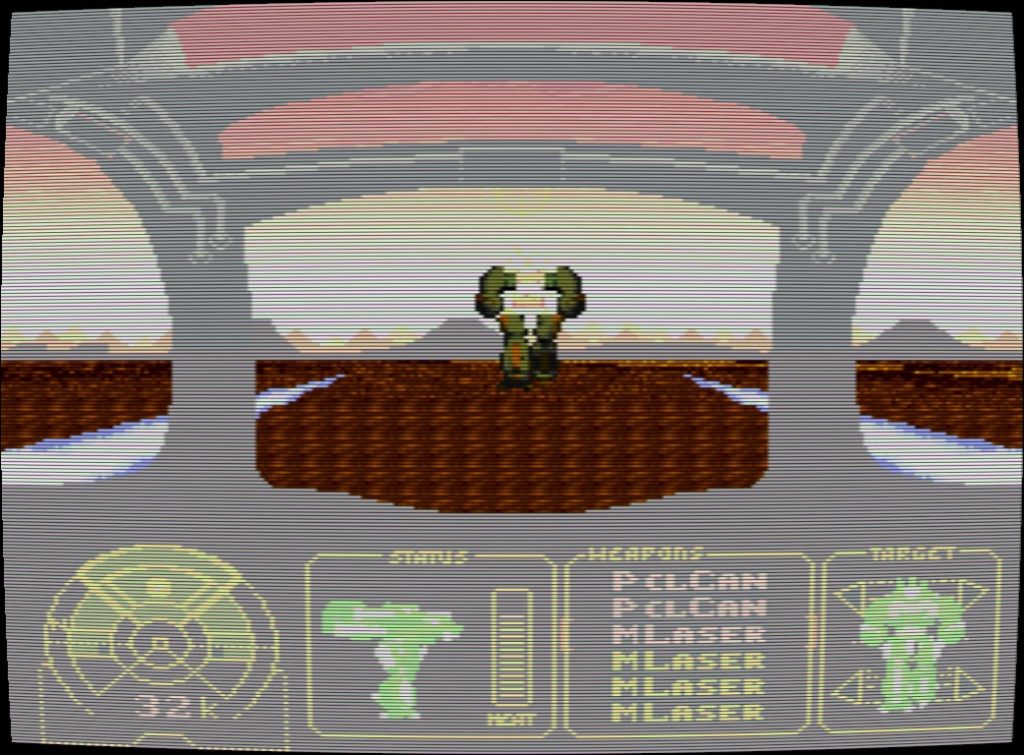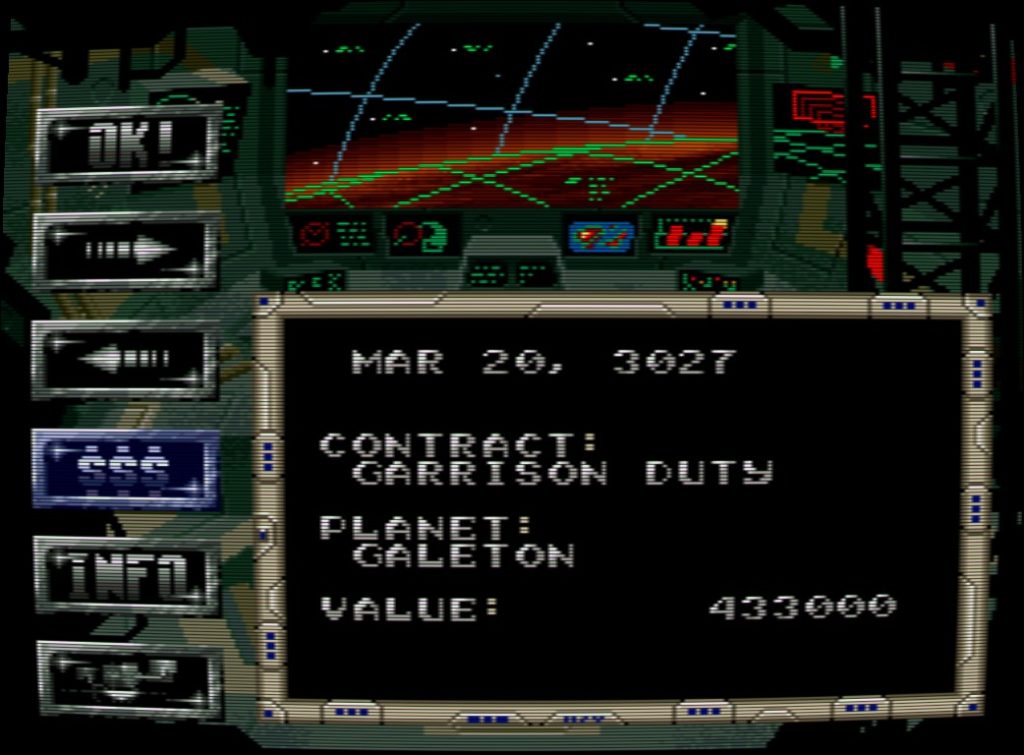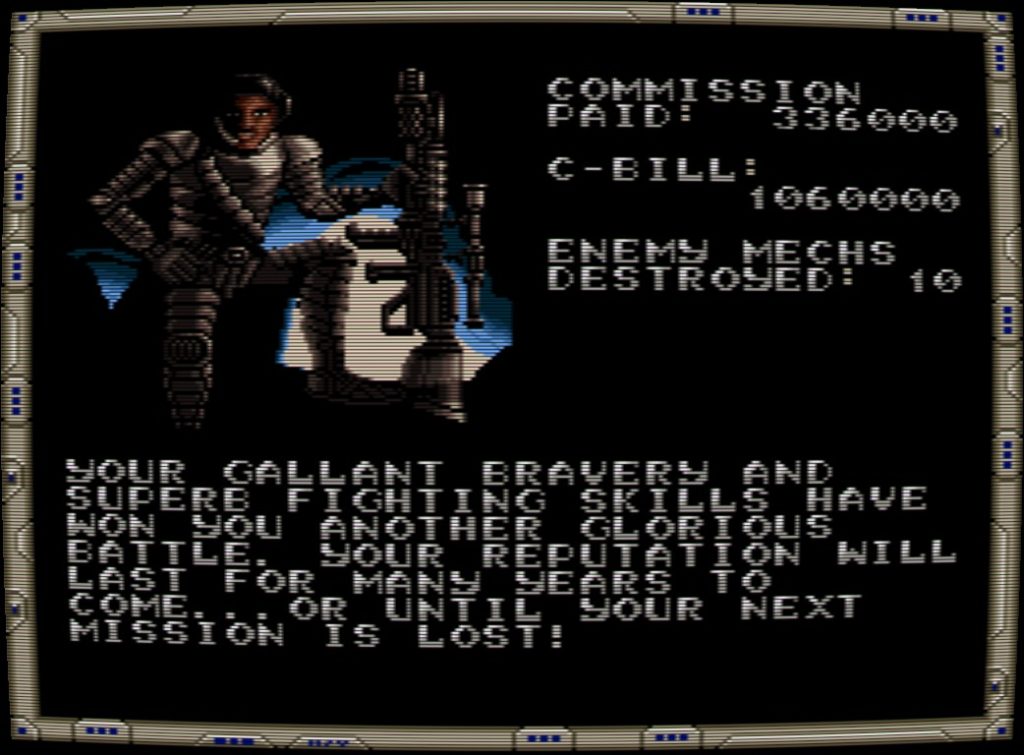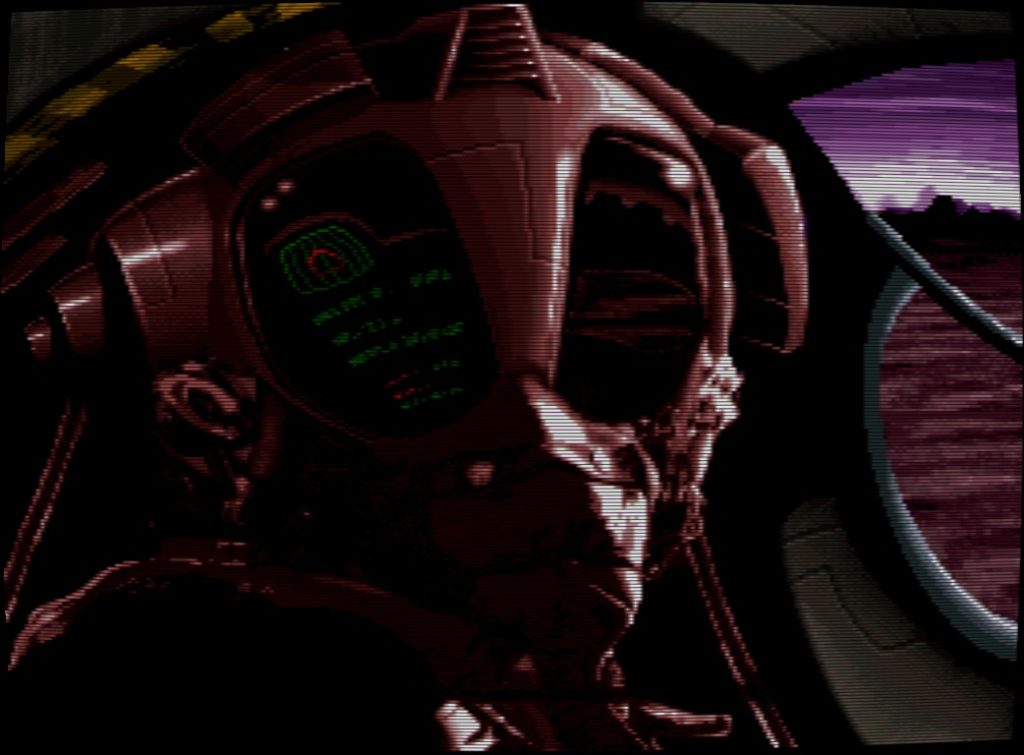
It’s not a giant Galactus tiara so a grognard has assuredly written a sternly worded treatise about this image’s canonicity. The pilot better be wearing an 80s thong bikini bottom or else!
Game Name: Mechwarrior (SNES version, 1993)
Developer: Beam Software
Platform: SNES (reviewed on a SNES emulator)
Categories: Remake of the 1989 release – Not a Port, Battletech Inspired, FPS Mech Sim, Merc Contracts, Objective Variety, 50+ Missions, Performance Rewards, Revenge Plot, Heavy Customization, Punishing Difficulty, Auditory Mess, Flashy Sprites/Effects, 3D Battles on a Flat Map, Open Arenas, Clunky Controls, RPG-Style Intermissions, Quirky Characters, Immersive World, Surprisingly Cyberpunk for this Universe
May Appeal To: Battletech diehards, Shadowrun junkies, just plain ol’ SNES owners
May Repulse: PC owners and people with discretionary gaming options
Comparable To: the hideous bot design and coloring found in Rise Of The Robots, the seedy bar sequences with mysterious characters like in various Shadowrun incarnations, “Tank! Tank! Tank!” without special abilities and you’re the sole target. But I found the largest similarities with the classic action of Battlezone – if you could blow off enemy limbs. This has less mission complexity than Mechwarrior 2, less everything than Mechwarrior 3, and more personality than Mechwarrior 4.
Learning Curve: 40 minutes for battle flow, mission selection, and bot building.
Game Length: 8 hours, give or take some retries
Difficulty: High, Brutal on several “boss” mechs
Mastery: If you feasibly execute a strategy other than kiting at distance, you’re an amazing player in my book. There are a large amount of missions and a fortune to amass though there isn’t a compelling reason to fight other than credits to purchase the higher tonnage mechs and discern your ideal loadout – which is attainable at the 50% marker.
An “iron man” run of no retries would be pretty impressive.
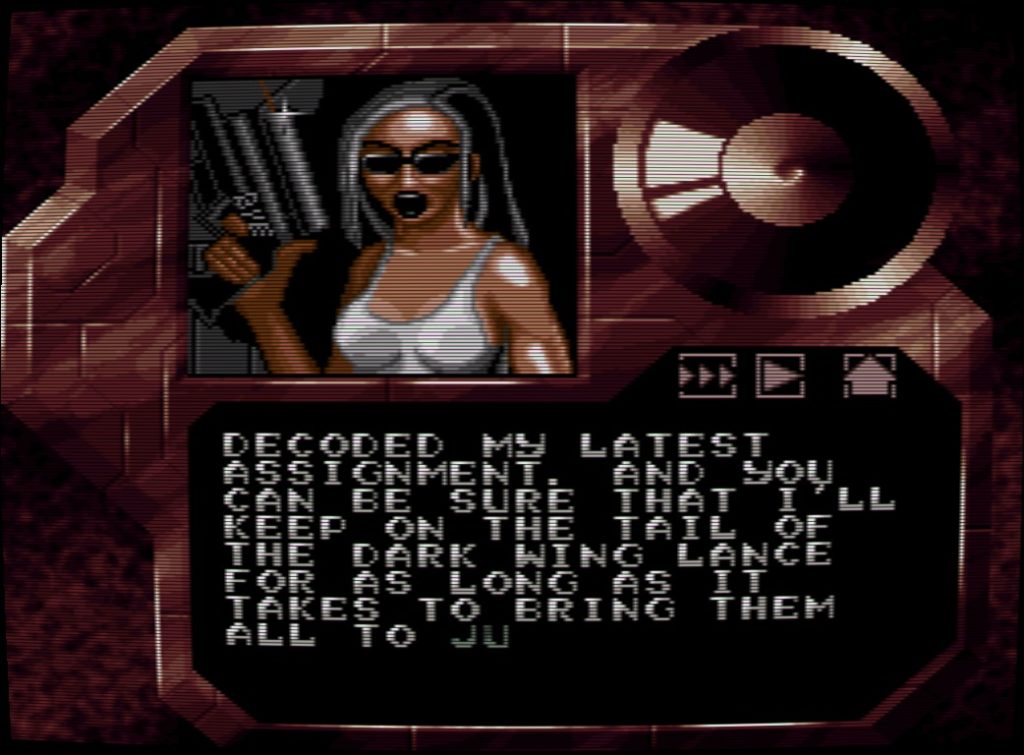
“I know why you’re here, Neo. I know what you’ve been doing. I know why you hardly sleep, why you live alone, and why night after night, you sit at your computer. You’re looking for him. “
Story: You’re Herras Ragen, a grimdark FedSuns mechwarrior bent on the eradication of four key members of a rogue mercenary cartel – the Dark Wing Lance, whom did the same to your family a decade back. Though a mere child at the time, Herras was propelled to don the mechwarrior’s neurohelmet and now whets his skills against the stone of experience as he racks up unbelievable kills in increasingly improbable missions.
The missions are scrupulously doled out from the comforts of some bar, the sociological nerve center to this haven. It doubles as an info hub and debriefing room to hear of your own exploits – Cearle’s ugly bartender mug greeting you after these excursions, his cybernetic eye drawing attention as he offers wisdom of which tasks to take and news of the changing political climate. Other mercantile individuals monologue via datapads or ask for direct assistance in specific contracts, alluring promises of fat credit stacks persuading counter to untrustworthy faces with untrustworthy words. Interactions feel very cloak-and-dagger, a prevailing doubt amidst the cast whom have little relationship with each other, an unmistakable danger lurking ’round every corner. They’ll critique and contradict as misinformation surfaces, the player needing to align expectations with truth in order to put down increasing tiers of bloodthirsty foes.
After considerable deployments the player catches matches pace with his quarry, four separate confrontations proving as strenuous as they were elusive. Did Herras absorb the skills to complete this journey after so many near-death experiences?
Quintessentially yet another revenge plot, this drama’s telling was effective enough for me to properly guess the motives of reoccurring NPCs and even anticipate future interactions. It shouldn’t come as a surprise, I suppose, but even the simplest of stories can generate immersion and a lasting impression. Though straightforward and peppered with the illusion of choice, the efforts to shroud the setting and mechanics in an air of desperation and mystery go a long way towards getting the player motivated enough for the slog.
Footnote: Despite having a compelling setting and storyline, most of the SNES game’s characters, worlds, plots, mechs, and even some of the technological details like inter-planetary travel times are not accepted as canon by the Battletech universe. This is unusual since the license has a general tendency of assimilating apocryphal sources and explaining inconsistencies as a form of unreliable accounts -from within- the universe.
Presentation: Whereas the original Mechwarrior worked with its limited palette of oversaturated and contrasting primary colors to establish an otherworldly sci-fi world, the SNES doubled-down on the budding edginess that 90’s media was known for. It suits the story’s noir cyberpunk mood, sure, though these identically-named games are night and day when compared. Although a lot of the charm was lost from bright, mostly-static images of ships and NPCs getting replaced by dreary, generic-looking clay figures flapping their gums, the combat sections are substantially more photogenic. I don’t want to undercut all the art assets -there’s genuine inspiration here like the war room and mech bay- but most of your gaze will be drawn to the sprite-filled chaos erupting on the battlefield. Too bad a couple of damning aspects wreck the entire experience, start to end.
- All mech designs are fugly and non-canon. (4 lights, 2 meds, 1 heavy, 1 assault)
It’s true that some of the original Battletech images were under dispute through a significant period of its history, though this can hardly be levied as an excuse since there are over a thousand distinct models. The Unseen aside, this game’s pseudo-Battletech trappings appear to take artistic license from the Japanese version of some classic mechs…. if you squint really hard. Anyhow, supplanting the meat and potatoes of this franchise with sharp-angled, alien abominations conjured up for this game alone is the best way to make nobody happy.
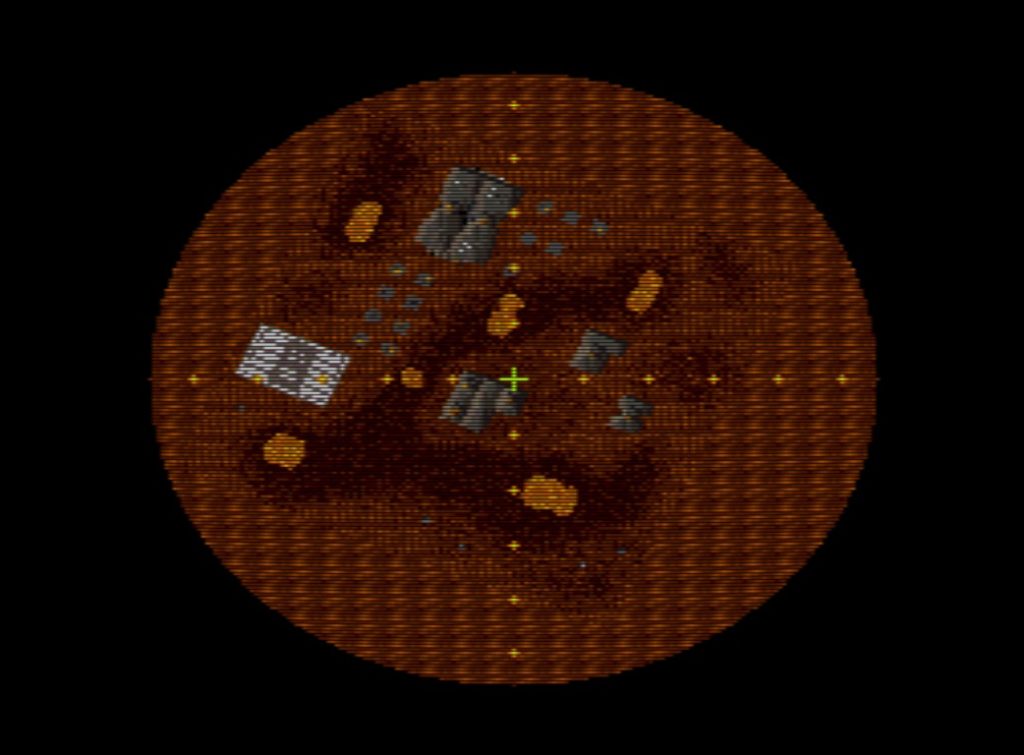
Pluck all vegetation. Level the landscape. Pour the foundations…. only the foundations. Unlike our topography, all bases are built with the -highest- precision.
2. Combat takes place on a flat, unobstructed plane.
Flat maps. No elevation, no terrain, just a 2D texture that 3D combat takes place on. The funny part is how every battle starts with a skydiver’s view of the field, giving the impression of unique topography before the angle shifts and the disappointment sets in. I got the sense that lava and water depictions hinder walking speed though the paper-thin “buildings” and other impediments have no battle impact whatsoever. In an ironic twist, this aspect reminds me very much of its 2D tabletop roots, except paper maps never repeat a bland tiling effect when you walk off nor loop back to the other edge after a quarter mile.
The SNES’s ‘mode 7′ rendering is touted for its scanline panning abilities, though I’m slightly less impressed due to #2 above. Still, the action is frenetic enough that players may lose sight of the fact that it’s all just uninhibited LOS in a simple skybox. Honestly it does look pretty good considering the flashes, shakes, explosions, and mech pieces flying all over the place, the cluttered HUD screaming warnings as your beleaguered mechwarrior is beset by leaping assault mechs on all sides. I’m being overly critical though. The locales are indeed attractive in most senses of the word; the sprites are varied and crisp, busy overall, but I’d argue it lends to the immersion (Mechwarrior is still fundamentally a “simulator”).
The faux blues MIDI trills accompanying your bar excursions, once again, are a great match for the private-eye-gumshoe genre that this game frequently mistakes itself for – a risky, but welcome, tone that mysteriously suits the experience. However, the repetitive blats, shhhYEEAAAs, and brief, tinny thumps denoting steps and weapons fire gets old real quick, especially if your build has duplicate armament. Despite (or because of) a lack of variance in the effects, I didn’t know a sounds’ origin half the time. My m’laser spamboat effectively employed a foley artist to knock around a brick inside a metal trash can that had its resonance prematurely cut short by the recording. +1 for liberal risks with audio design. -2 for my poor ear drums.
Unique Features: The elements are all there: an adult sci-fi narrative skating the rim of ‘edgy’ and ‘classic’, deep and challenging mech customization, mission choice and negotiation, deconstructable opponents that lose limbs to focused weapon blasts.
Gameplay: Shockingly, the least remarkable element is the very thing the game expects you to spend the most time doing. If there were hills, bottlenecks, ANY terrain to take a marginal tactical advantage from, my opinion would be completely different. However, we’re stuck with a flat arena shooter that plays without surprises each and every time. There are speedy and jumpy (hover) mech builds of course but the turn rate and proficiency of enemies in close combat makes these nigh untenable. I found the greatest success in aligning my facing towards incoming tracer rounds (which show up on the mini-map, helpfully) and slamming the fire button while mindlessly kiting the target at an ideal range, hoping a yellow spawn point didn’t appear in my immediate proximity. Depressing a button to modulate a clunky cursor is tough enough to wield, though firing at the flashing torso section never posed much of a challenge at all due to how slow it all is.
This combat ease is a reward reaped from the seeds sown in the mech hangar. It’s sincerely tough to pick up at first, given the fact that your max tonnage, weapon weight, weapon damage, and precise heat buildup stats are all obscured from view. After a few rounds against obscenely imbalanced odds though, you’ll develop a personal preferences in jump/running speed, armor allocation, firing rhythm, and weapon combos. This whole process of tweaking the heaviest, affordable warframe of destruction is the highlight of any Mechwarrior title, but remember that ammo and armor are paid commodities in this world of financial independence and responsibility.
Deciding where and who to fight is nearly as entertaining, though woefully underutilized for the multiple endings and benefits that could have been rolled in. The local dive of your adopted headquarters is a pub with characters galore, each seeming to teeter on the edge of undercutting associates or just cutting a deal. Though less exciting when described, the player has the optional task of selecting a few babbling informants (bartender, data pad, the television, or fellow merc) between missions, which subsequently rattles off its rumor/intrigue spiel – clues on whatever available contract will further the plot. Whether it be the direct name of a planet, a mission description, or even something as cryptic as “an island shaped like a bat” (Galeton, it’s Galeton), the player controls how straight their story path becomes by how astute their attention is. Sadly, all roads still lead to a single endpoint: ball-busting bosses with triple the health of their subordinates cloud.
Mission variety, you ask? Of course! We call a deathmatch all sorts of fancy names.
Additional Comments: Because of how much I disliked the actual combat I relished in every intermission detail. The Davions are so fickle with contract agreements regardless of whatever fractional pittance you earn on a successful negotiation roll. It’s certainly possible to grind out a full bankroll though I encourage save scumming once the impact of mech design decisions start to accumulate and have financial consequences.
What I Liked: I liked the execution of this simplistic story, the out-of-cockpit elements, most of the graphics, the “sleuthing” during mission selection, and contract haggling.
What I Disliked: Sound effects ring sharply monotonous and the lack of any recognizable mech designs is an affront to the original creators of the DOS game along with the franchise itself. The final nail in the coffin is the flat levels utterly devoid of nuance or distinguishing features. Combat feels like beta testing an unfinished system and the controls drive the point home that a mouse or joystick are superior for an independent targeting cursor. On top of it all, the only playstyle worth a damn is kiting due to the accuracy, jumping proficiency, and turn speed of enemies.
Glitches Experienced: It’s likely my emulator’s fault since I’ve seen the issue arise in Pilotwings, but jumping will occasionally induce nausea via this weird FOV effect. It reminds me of a cinematic trick where the camera dolly recedes while the lens zooms in. I’m unsure if the symptom would be present in a physical cartridge however.
Hours I Played: ~10
My Personal Reaction: I feel tricked. Four years passed between the DOS and SNES versions and yet this is not an across-the-board improvement. Some presentation elements got a boost, obviously, yet almost all other elements suffered concessions in design and brand recognition. (New mechs, planets, characters, and being the first game in a series, this could have been called anything else.) The game hails from an era where advertisements deceptively said a title would release on various platforms of differing technological ability, though this Mechwarrior feels downright fraudulent to me.
Noob Tips: For a cheap, easy, sustainable build just dump your tonnage into medium lasers, the slowest/lightest engine, emergency jump jets, and a -4 heat modifier. The remaining weight can reinforce armor. Damage per second is of the utmost importance for base defense missions and these tips allow for indefinite fire at good range.
Depth and Replayability: High depth outside of combat. It’s possible to go bankrupt and missions repeat so I’d say that it’s created with replayability in mind, whether or not the player consents to this.
Suggested Value: $1, $10 for a physical cartridge
Where to Buy: eBay, local classic gaming store
Subjective Categorical Ranking:
(Platform capabilities are considered for Graphics and Sound)
| poor || bad || average || good || great |
Fun Factor |█████████
Unique Gameplay |████████████████
Controls & UI |█████
Story & Lore |█████████████████████
Graphics & Style |████████████████
Sound & Music |█████████


